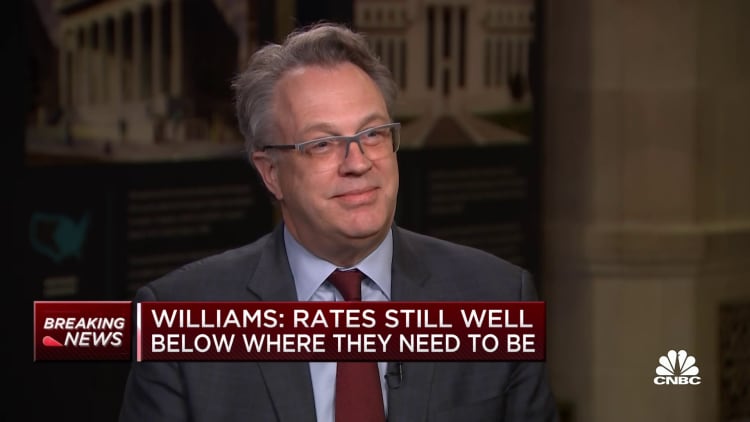
New York Federal Reserve President John Williams said Tuesday he expects the U.S. economy to avoid recession even as he sees the need for significantly higher interest rates to control inflation.
"A recession is not my base case right now," Williams told CNBC's Steve Liesman during a live "Squawk Box" interview. "I think the economy is strong. Clearly financial conditions have tightened and I'm expecting growth to slow this year quite a bit relative to what we had last year."
Quantifying that, he said he could see gross domestic product gains reduced to about 1% to 1.5% for the year, a far cry from the 5.7% in 2021 that was the fastest pace since 1984.
"But that's not a recession," Williams noted. "It's a slowdown that we need to see in the economy to really reduce the inflationary pressures that we have and bring inflation down."
The most commonly followed inflation indicator shows prices increased 8.6% from a year ago in May, the highest level since 1981. A measure the Fed prefers runs lower, but is still well above the central bank's 2% target.
'Far from where we need to be'
In response, the Fed has enacted three interest rate increases this year totaling about 1.5 percentage points. Recent projections from the rate-setting Federal Open Market Committee indicate that more are on the way.
Williams said it's likely that the federal funds rate, which banks charge each other for overnight borrowing but which sets a benchmark for many consumer debt instruments, could rise to 3%-3.5% from its current target range of 1.5%-1.75%.
He said "we're far from where we need to be" on rates.
"My own baseline projection is we do need to get into somewhat restrictive territory next year given the high inflation, the need to bring inflation down and really to achieve our goals," Williams said. "But that projection is about a year from now. Of course, we need to be data dependent."
Some data points lately have pointed to a sharply slowing growth picture.
While inflation runs at its highest level since the Regan administration, consumer sentiment is at record lows and inflation expectations are rising. Recent manufacturing surveys from regional Fed offices suggest activity is contracting in multiple areas. The employment picture has been the main bright spot for the economy, though weekly jobless claims have been ticking slightly higher.
An Atlanta Fed gauge that tracks GDP data in real time is pointing to just a 0.3% growth rate for the second quarter after a 1.5% decline in Q1.
Williams acknowledged that "we're going to have lower growth, but still growth this year."
In addition to rate hikes, the Fed has begun to shed some of the assets on its balance sheet — particularly Treasurys and mortgage-backed securities. The New York Fed is in the early stages of a program that eventually will see the central bank allow up to $95 billion in proceeds from maturing bonds roll off each month.
"I'm not seeing any signs of a taper tantrum. The markets are functioning well," Williams said.
A St. Louis Fed indicator of market stress is running around record lows in data that goes back to 1993.


